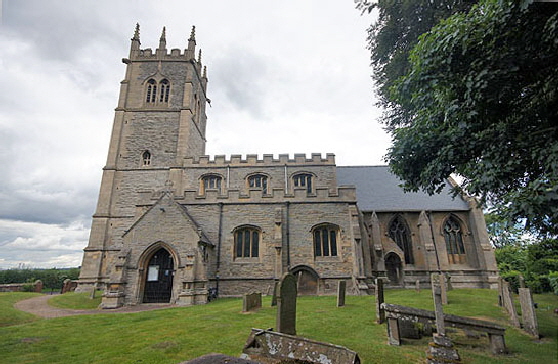|
|
||||||||||||||||||||||||||||||||||||||||||||||||||||||||||
|
Please sign my Guestbook and leave feedback |
||||||||||||||||||||||||||||||||||||||||||||||||||||||||||
|
Recent Additions |
||||||||||||||||||||||||||||||||||||||||||||||||||||||||||
|
|
||||||||||||||||||||||
|
Easter Sepulchres were swept away in Edward VI’s protestant Church although some survived to be briefly used again during Mary I’s Catholic revival. The survival of this magnificence at Hawton was down to the fact that it was hidden under layers of plaster and whitewash until it was rediscovered in the 1843-4 restoration. Its significance can be measured by the fact that a plaster copy of the entire triple composition on the north wall was exhibited at the Great Exhibition in 1851. Sadly, the sepulchre did not escape the iconoclasts altogether before it was hidden. As at Heckington, both sepulchre and sedilia surprise the observer by being decorated with pagan and satirical carvings as well, of course, with the expected Christian imagery. No church better illustrates the robust self-confidence of the fourteenth and fifteenth century mediaeval church and its masons than such carvings should appear in the holiest part of the church. All this just fifty years after the end of the Early English period when, for reasons we can’t fathom, decorative carving had entered an extended hiatus. |
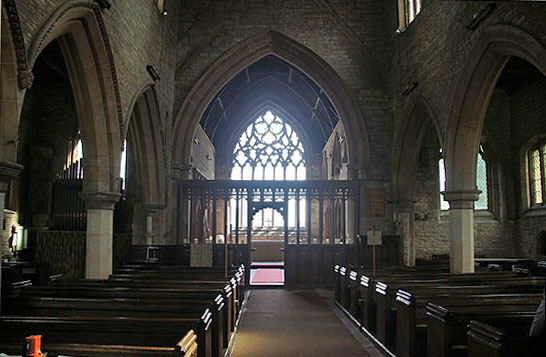 |
||||||
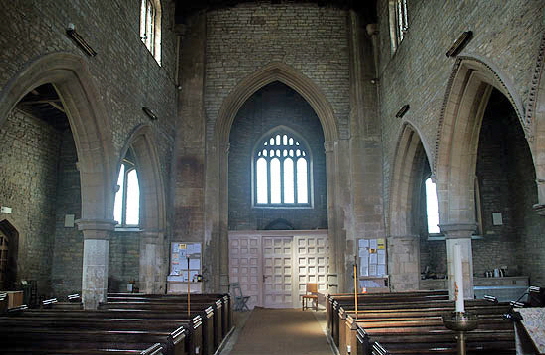 |
||||||
|
Left: The view to the east with its beautiful and enormous Decorated style east window. The wooden screen is also fifteenth century, another fortunate survivor. Right: Looking towards the west. The Perpendicular style west window suffers from comparison with the beauty of much of the rest of the church. |
||||||
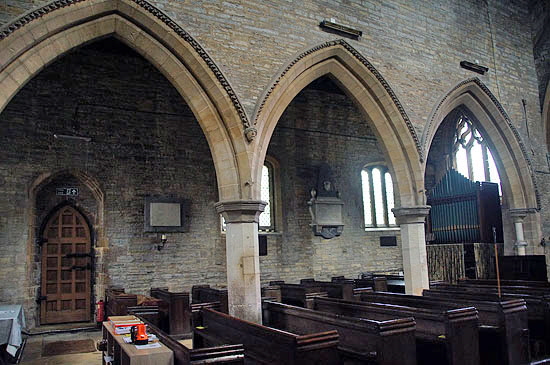 |
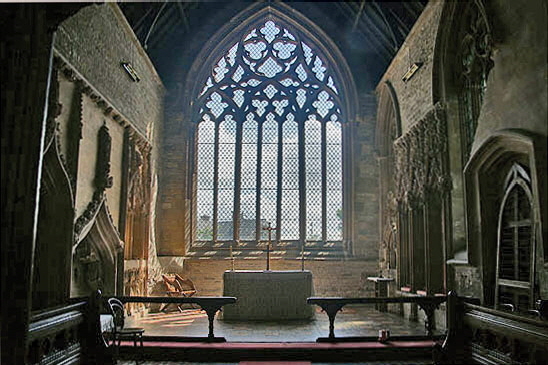 |
|||||
|
Left: The thirteenth century north arcade. Note the vaguely Romanesque style decorative course around the arches. This was a church where everything wa executed with confidence. Right: The chancel. To the left is the remarkable composition of doorway, tomb and (nearest to the window) easter sepulchre. To the right is the wonderful triple sedilia and - just visible - the piscina. Before looking at the chancel furnishings in detail, however, take a long look at the east window with its superb Decorated style tracery. Look carefully at the quatrefoil on the left of the window at the bottom of the tracery. You can see the distortion caused by subsidence of the church. |
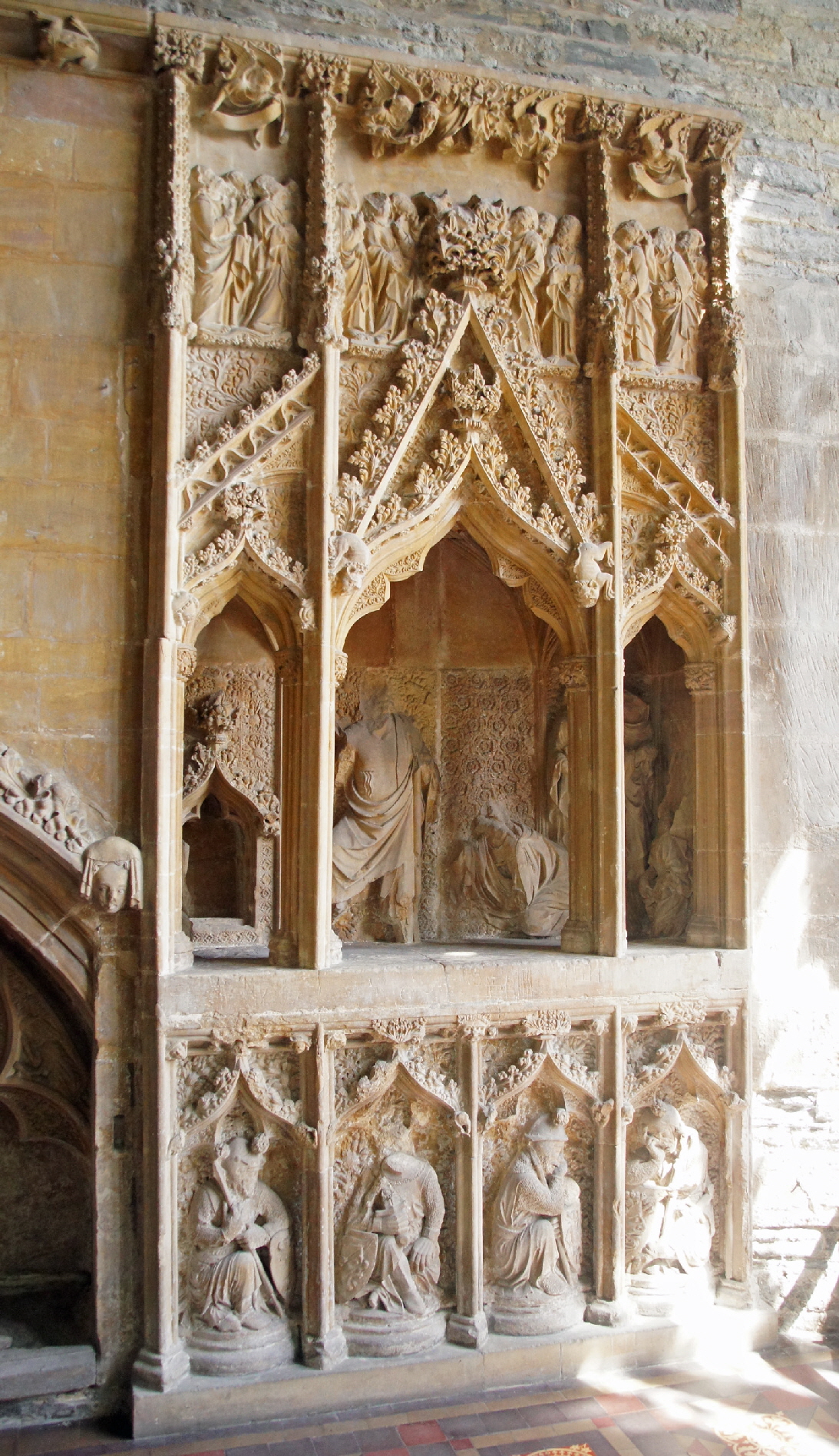 |
|||||||||||||||||||||||||||||||||||||||||||||||||||||
|
The Easter Sepulchre. The recess into which the host would have been placed between Good Friday and Easter Sunday is in the central section to the left. It would have had a lockable door. The risen Christ is to the right of the recess. One of the three Marys weeps at His feet while the other two stand to the right (hidden in this picture). Carved into the plinth are the traditional four sleeping Roman soldiers who were supposed to have been guarding the tomb. One has lost his head but the other three are pictures of blissful unconcern. As we shall see, their garments and shields are contemporary. At the top of the sepulchre the Virgin Mary and the eleven remaining disciples look to Heaven. |
|||||||||||||||||||||||||||||||||||||||||||||||||||||
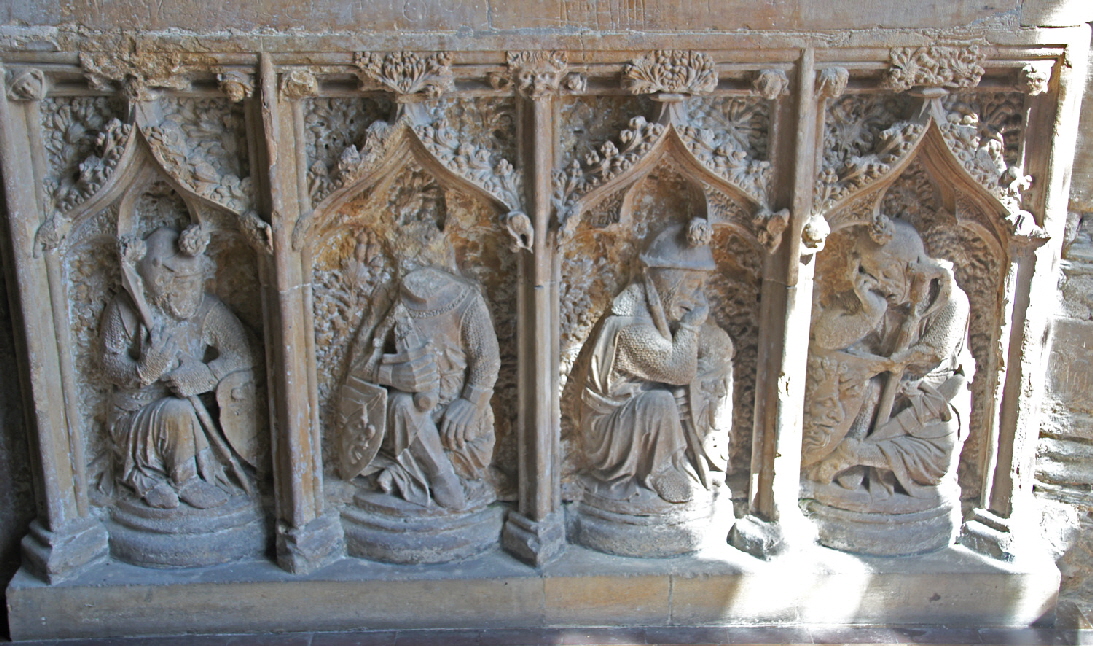 |
|||||||||||||||||||||||||||||||||||||||||||||||||||||
|
The four unsuspecting Roman guards. My favourite is the one on the right. He looks as if he’s nursing a hangover! Note the small carvings at the top of the plinth and, in particular, the little grotesque with his mouth around the top of the central upright. |
|||||||||||||||||||||||||||||||||||||||||||||||||||||
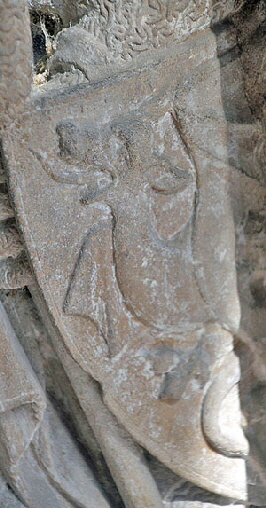 |
|||||||||||||||||||||||||||||||||||||||||||||||||||||
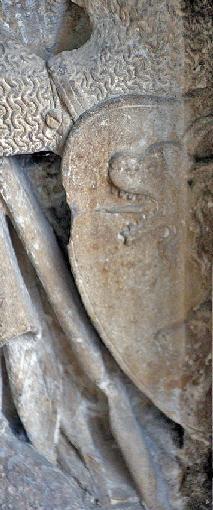 |
 |
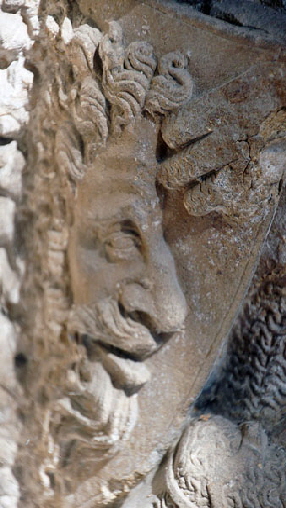 |
|||||||||||||||||||||||||||||||||||||||||||||||||||
|
The four shields held by the guards are worthy of closer examination. They are in the best traditions of eccentric self-indulgence on the parts of the masons. Far Left and Far Right are two versions of dragons. They are far more lifelike (if one can use that term when referring to mythological figures!) than those seen in conventional heraldry. Best of all is the ugly face Second Left. The nose and ears are monstrous and there is surely some satire intended here? Second Right is a man’s face with a considerable mane of hair. Even in the holy of holies, the chancel, the English masons couldn’t keep a straight face and it is a remarkable but indisputable fact that the clergy were perfectly prepared to share in the joke. |
|||||||||||||||||||||||||||||||||||||||||||||||||||||
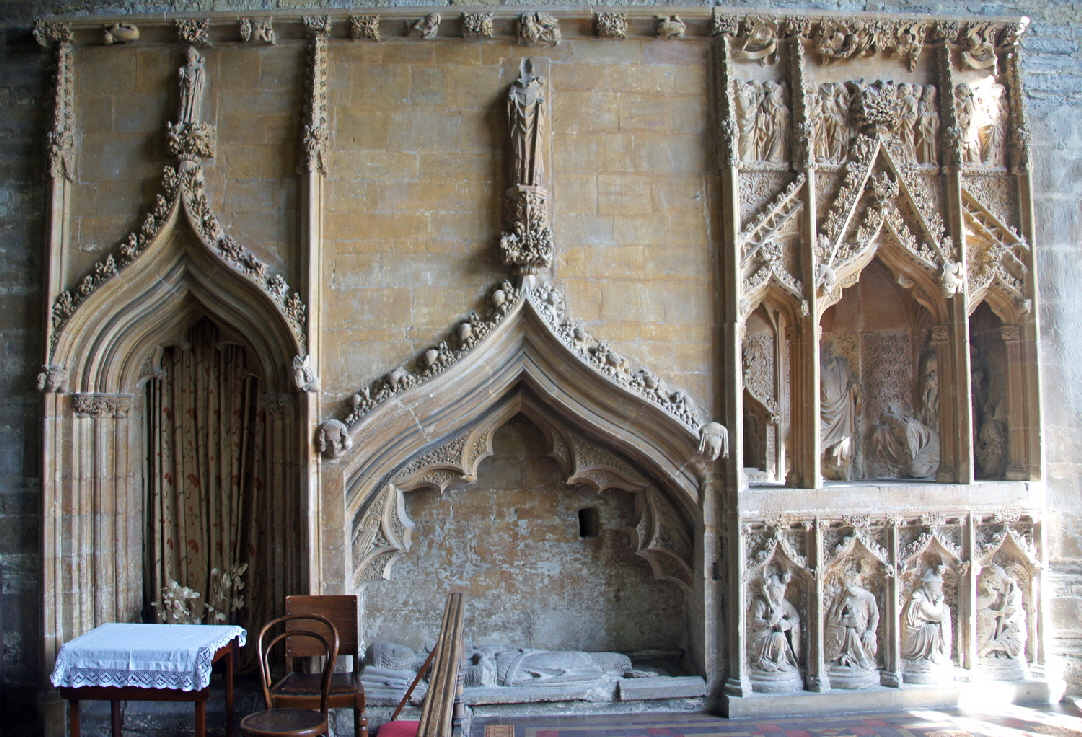 |
|||||||||||||||||||||||||||||||||||||||||||||||||||||
|
This picture makes clear that north door, tomb and easter sepulchre were all part of one composition. It is all framed together, proud of the wall behind and carved from different stone. The effigy is believed to be of Sir Robert de Compton who died in 1330 and who commissioned the chancel. The figure above the niche has been defaced and is probably St Thomas a Becket. Henry VIII hated the Becket cult because Thomas championed the Church’s independence from the State. It is also widely believed, however, that it was moved here from elsewhere in the church. That implies that the splendid furnishings here were probably not contemporary with the building of the chancel itself. Indeed, to my eyes this rich carving looks too sophisticated for the early part of the fourteenth century and is much more in the Perpendicular than in the Decorated style. Note the decorative frieze at the top of the “frame” to the left of Easter Sepulchre. These carvings are whimsical and distinctly non-religious in the best traditions of East Midlands churches, although to find them in the chancel and next to the sepulchre is only to emphasise the very un-stuffy attitude to decoration in the mediaeval Church of the time. Note also the squint in the wall of the tomb. There was a hermit - Peter de Whitelegge (or Whitteley) - here in 1330. There is speculation that this squint was for his benefit but there was a north chapel here at one time and it is more likely that this was for the benefit of the priest. |
|||||||||||||||||||||||||||||||||||||||||||||||||||||
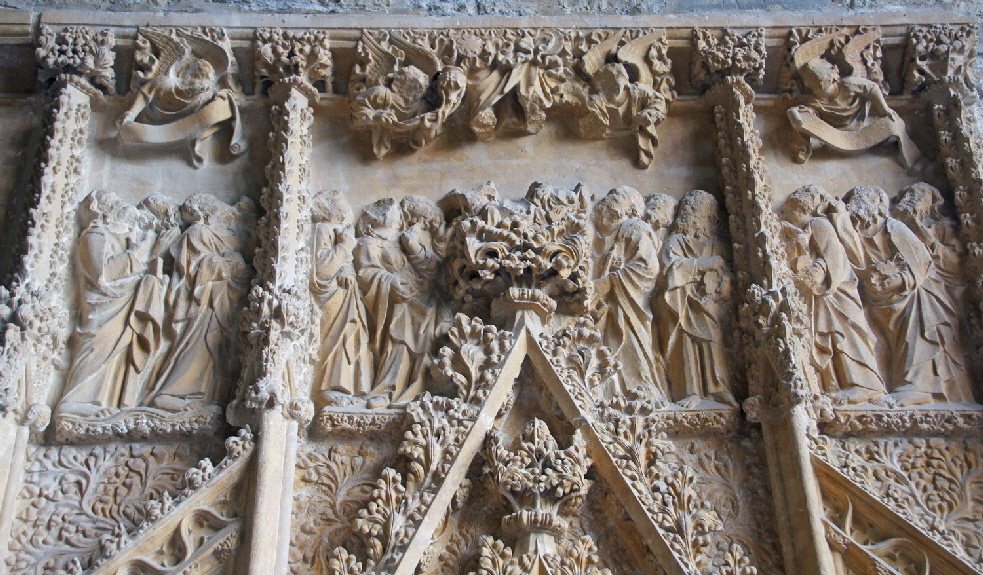 |
|||||||||||||||||||||||||||||||||||||||||||||||||||||
|
The ascension scene at the top of the sepulchre. Immediately to the right of centre is St Peter with his key. Mary in in the middle of the group of three left of centre and can be identified by being the only figure wearing shoes. In between these two sets of figures is a cluster of decoration and if you look very carefully at the top of this you can see a footprint, its toes towards you. This represents Christ’s last footstep on earth. The faces of most of the disciples have been damaged, presumably deliberately, but not very enthusiastically so that some facial features are still visible. |
|||||||||||||||||||||||||||||||||||||||||||||||||||||
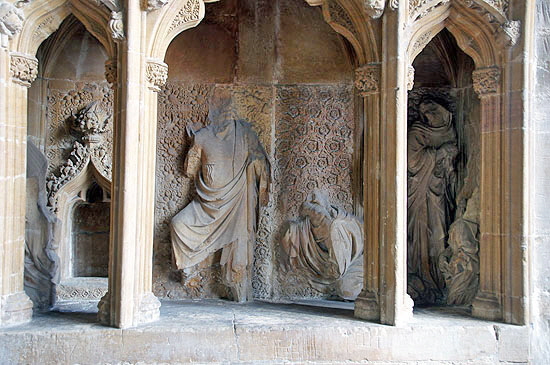 |
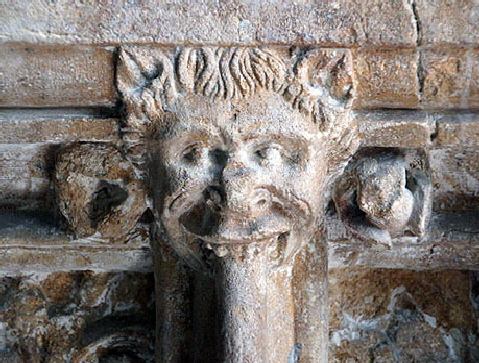 |
||||||||||||||||||||||||||||||||||||||||||||||||||||
|
Left: The resurrection tableau within the sepulchre. Mary Magdalene with her ointments and spices is at Christ’s feet. All the figures have been grievously damaged. Right: On the plinth this cute little monster playfully devours some of the masonry. |
|||||||||||||||||||||||||||||||||||||||||||||||||||||
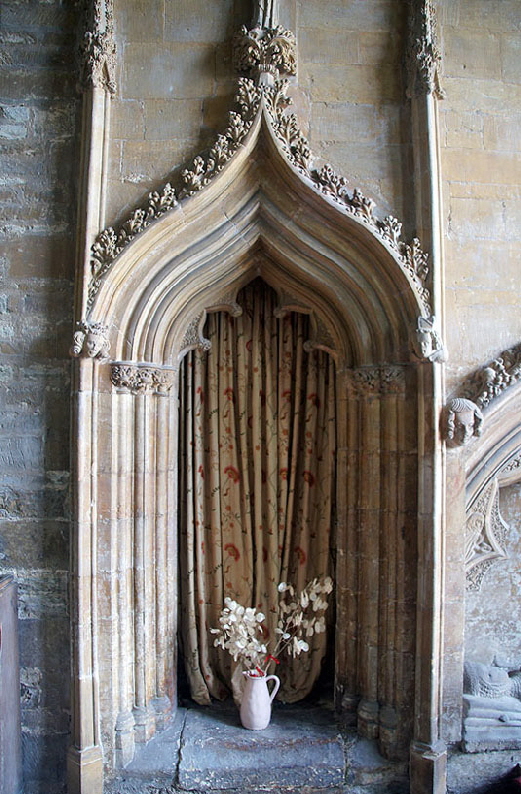 |
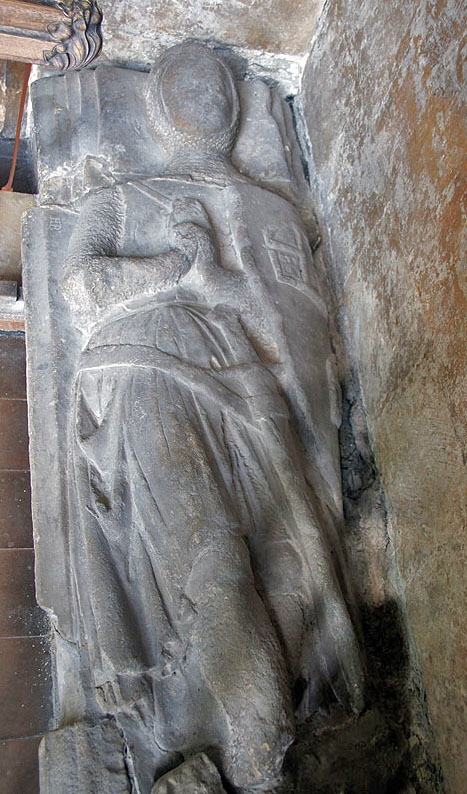 |
||||||||||||||||||||||||||||||||||||||||||||||||||||
|
Left: The blocked north doorway. Right: The supposed effigy of Sir Robert de Compton |
|||||||||||||||||||||||||||||||||||||||||||||||||||||
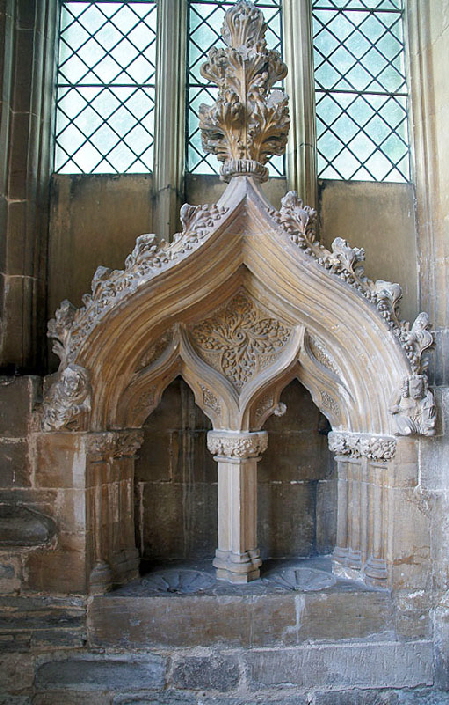 |
|||||||||||||||||||||||||||||||||||||||||||||||||||||
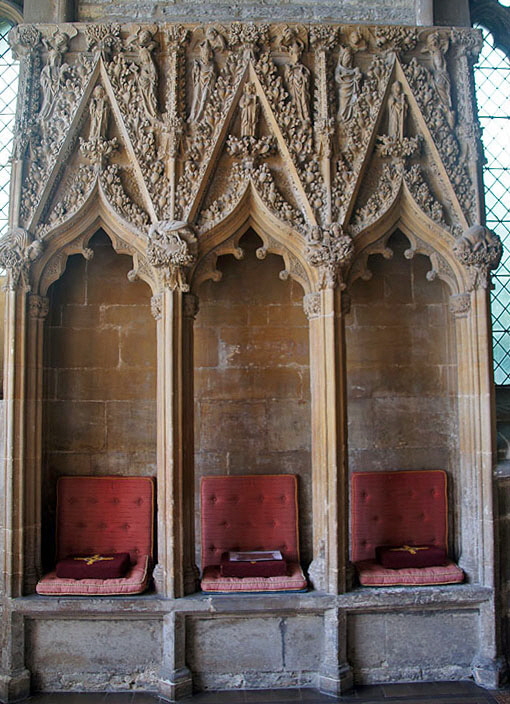 |
|||||||||||||||||||||||||||||||||||||||||||||||||||||
|
Left: The triple sedilia. Right: The piscina. |
|||||||||||||||||||||||||||||||||||||||||||||||||||||
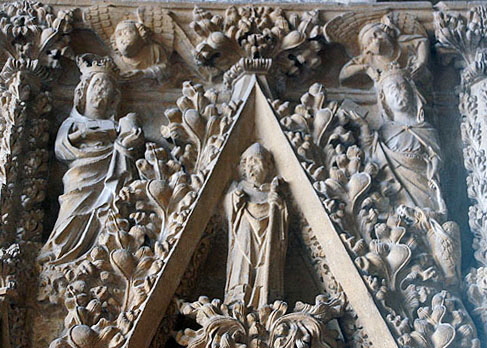 |
 |
||||||||||||||||||||||||||||||||||||||||||||||||||||
|
Detail from the sedilia canopy. Left: The central figure is hard to identify. He has a bishop’s mitre and carries a staff so he might be St Nicholas. To his left St Mary Magdalene holds a jar of ointment. To the right St Margaret of Antioch has a vicious looking dragon on a leash at her feet. Right: St Peter holds his key on the left. On the right is St Clement with an anchor. A rather lesser known saint, the poor chap was thrown into the sea with an anchor around his neck by the Emperor Trajan. In the centre St Edmund clutches an arrow which needs no explanation. |
|||||||||||||||||||||||||||||||||||||||||||||||||||||
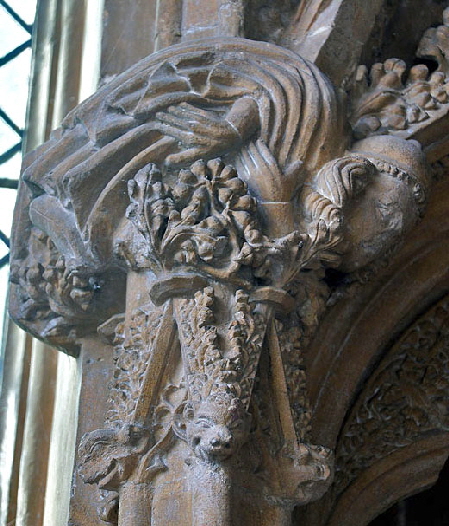 |
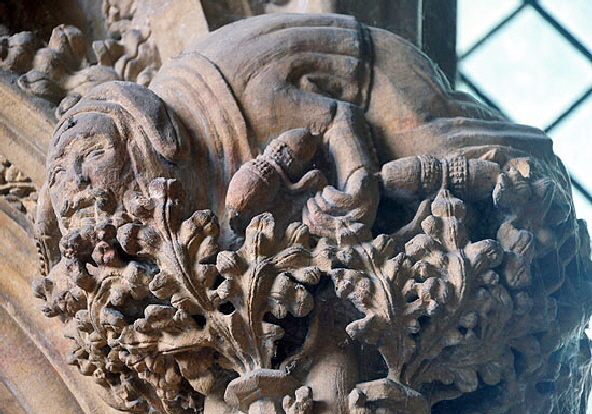 |
||||||||||||||||||||||||||||||||||||||||||||||||||||
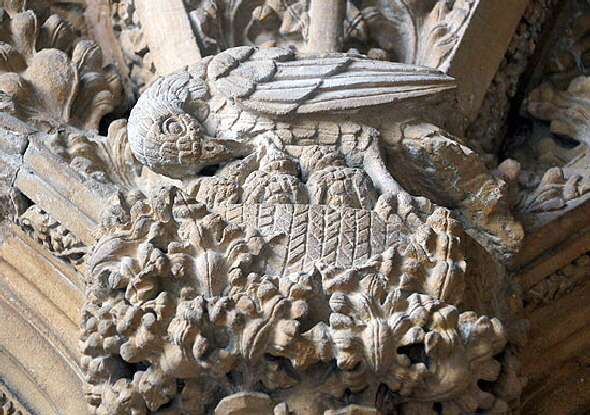 |
|||||||||||||||||||||||||||||||||||||||||||||||||||||
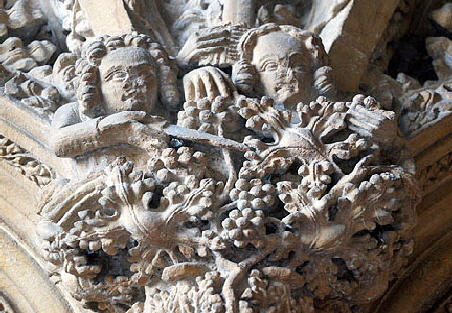 |
|||||||||||||||||||||||||||||||||||||||||||||||||||||
|
Top Left and Right: I’m struggling to identify these two figures from either end of the sedilia. Both are bending over and seemingly entwined with oak leaves. The figure on the right is also surrounded by acorns. The figure on the left is not - but is that an acorn on his head? Lower Left: Two men are cutting grapes. If you look carefully at the man on the right he is using his free hand to comb his hair! Lower Right: The pelican plucks at his breast to shed blood in a timeless allegory of the blood shed by Christ. |
|||||||||||||||||||||||||||||||||||||||||||||||||||||
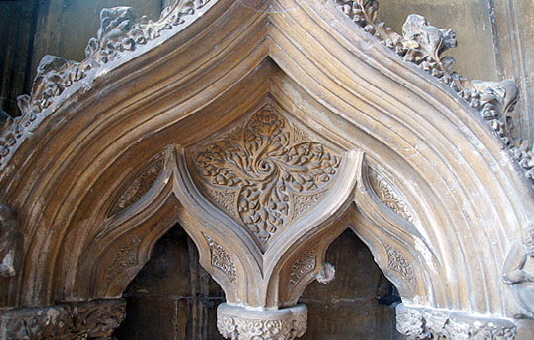 |
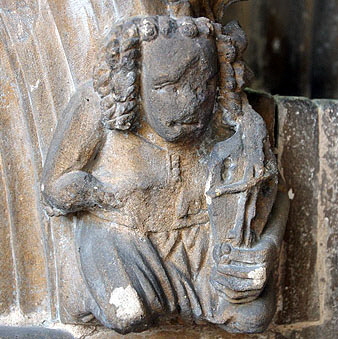 |
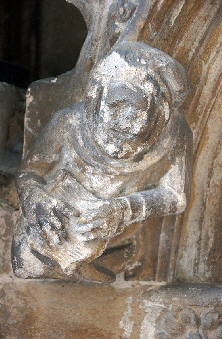 |
|||||||||||||||||||||||||||||||||||||||||||||||||||
|
Left: Detail of the piscina. Centre: The piscina has carvings on either end of the main canopy. This one plays a rebec, although is arm and his bow have disappeared. Right: Another instrumentalist plays a psalter.. |
|
|
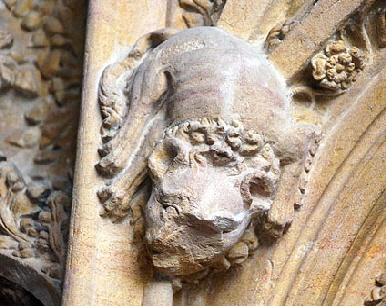 |
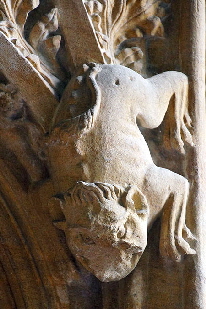 |
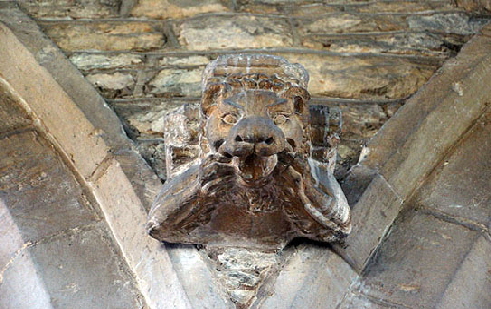 |
||
|
Left and Centre: These two beauties are on either side of the central tableau on the easter sepulchre. They are a little battered and as they are not religious images there is no good reason for them to have been defaced. The sepulchre is quite battered really and it seems like there was just some all-purpose vandalism going on. The sedilia, by contrast, seems to have got off scot-free. Right: A grotesque girns out from one of the arch spandrels. |
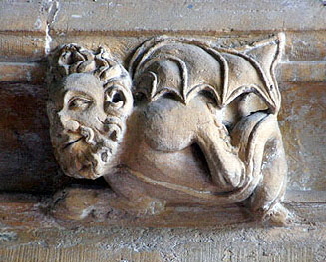 |
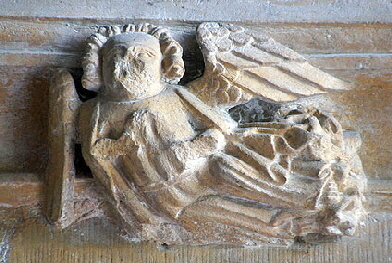 |
|||||||||||||||||||||||||||||||||||
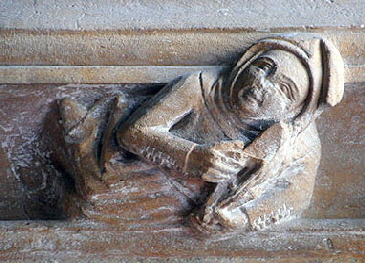 |
||||||||||||||||||||||||||||||||||||
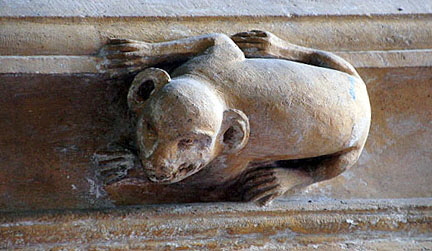 |
||||||||||||||||||||||||||||||||||||
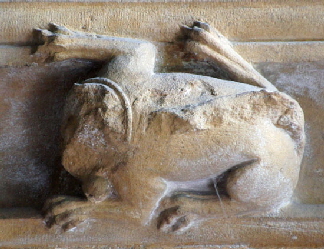 |
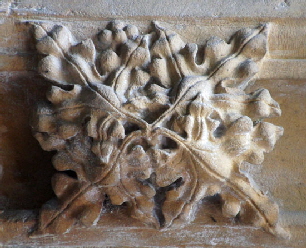 |
|||||||||||||||||||||||||||||||||||
|
Carvings from the top margin of the north side grouping. Again, one can only marvel at the robust imagination at work here. |
||||||||||||||||||||||||||||||||||||
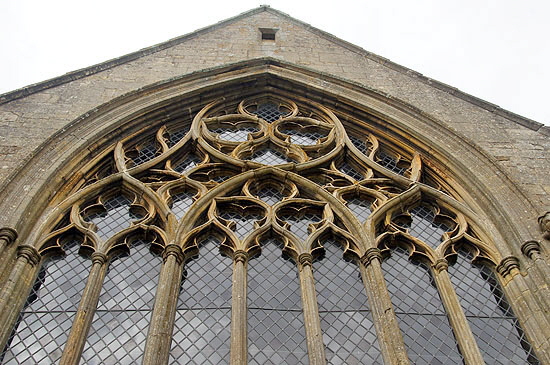 |
 |
|||||||||||||||||||||||||||||||||||
|
Left: The east window tracery. Right: The west door is a very interesting piece of work indeed and, as I have argued above, almost certainly commissioned by Sir Robert Molyneaux in 1482. I believe that the design reminiscent of a Decorated period window deluded Pevsner into thinking it was earlier. |
||||||||||||||||||||||||||||||||||||
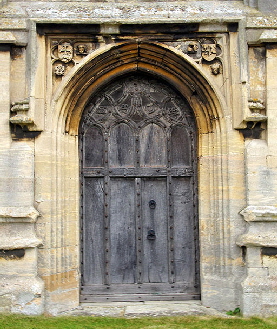 |
||||||||||||||||||||||||||||||||||||
 |
||||||||||||||||||||||||||||||||||||
 |
||||||||||||||||||||||||||||||||||||
|
Left: The west door. Centre and Right: The carvings within the spandrels of the west door. On both sides you can see arms sporting the Maltese cross that featured in the arms of the Molyneaux family. That on the left has a splendidly playful looking dog. The left spandrel has a Tudor rose that and the king on the right spandrel is then surely Henry VII. A little dragon curls up next to the shield. He’s a pretty little fellow. All say aaaaah. Henry VII himself was generally thought of as a morose skinflint. You can still see a ghost of a smile on this carving, however. It’s an unusually jolly little composition all round. |
||||||||||||||||||||||||||||||||||||
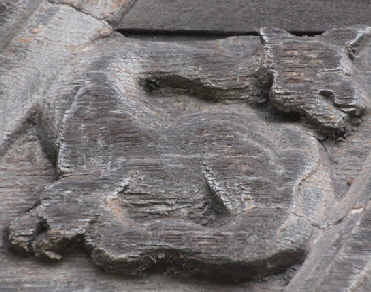 |
||||||||||||||||||||||||||||||||||||
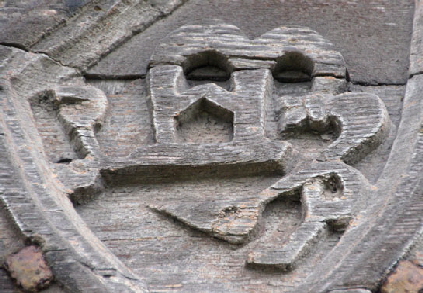 |
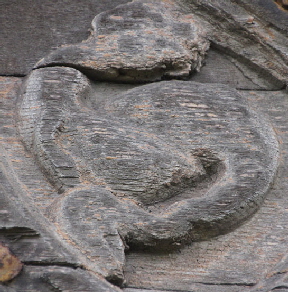 |
|||||||||||||||||||||||||||||||||||
|
Three of the carved designs on the west door. The dragon or dog here (right) has a more customarily aggressive look about him. I assume that the design on the left is a monogram of the Molyneaux family although I can’t work out the detail of the design so I might be completely wrong. The design is repeated, though, so I would be surprised if it was not a Molyneaux device. |
||||||||||||||||||||||||||||||||||||
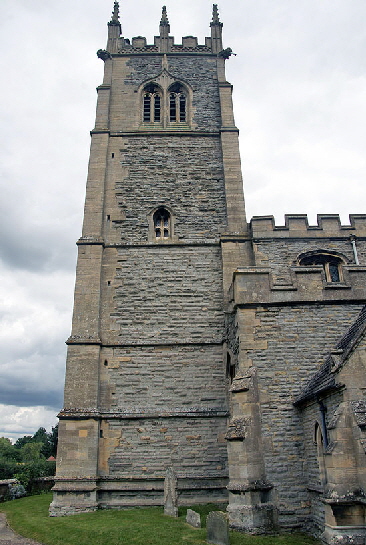 |
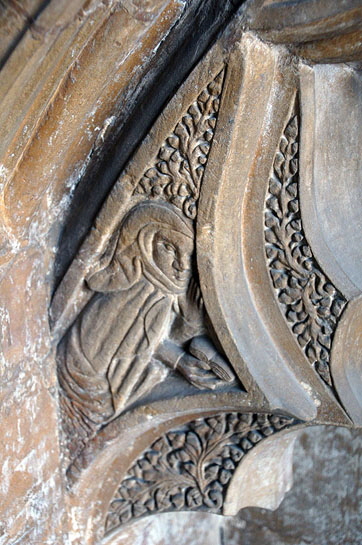 |
|||||||||||||||||||||||||||||||||||
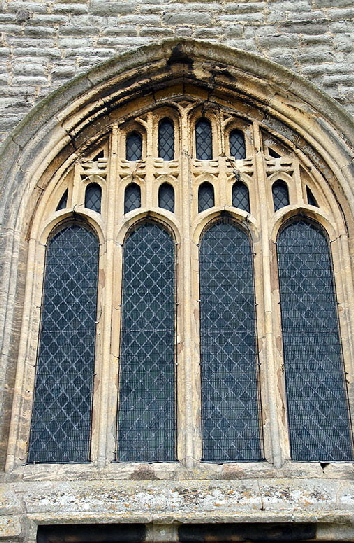 |
||||||||||||||||||||||||||||||||||||
|
Left: The west window from the fourteen eighties should be compared with the picture of the east window above to demonstrate how window design changed over fifty years as the Decorated style gave way to the Perpendicular. It is sobering to reflect that in between the building of these two windows Hawton would, like the rest of England and most of Europe, have lost about half of its population to the Plague. There is nothing unpleasant about this west window but it is industrial-looking compared with its counterpart at the east end with its lovely flowing tracery and it was quite possibly carved at the quarry and transported here in ins constituent parts on the back of carts. No wonder the art declined: fifty percent of the masons would have died too. Centre: The west tower. Right: Everywhere you look in the chancel there are carvings to be seen. This ”weeper” with a book hides on the outside of the de Compton tomb. |
||||||||||||||||||||||||||||||||||||
|
|
||||||||||||||||||||||||||||||||||||
